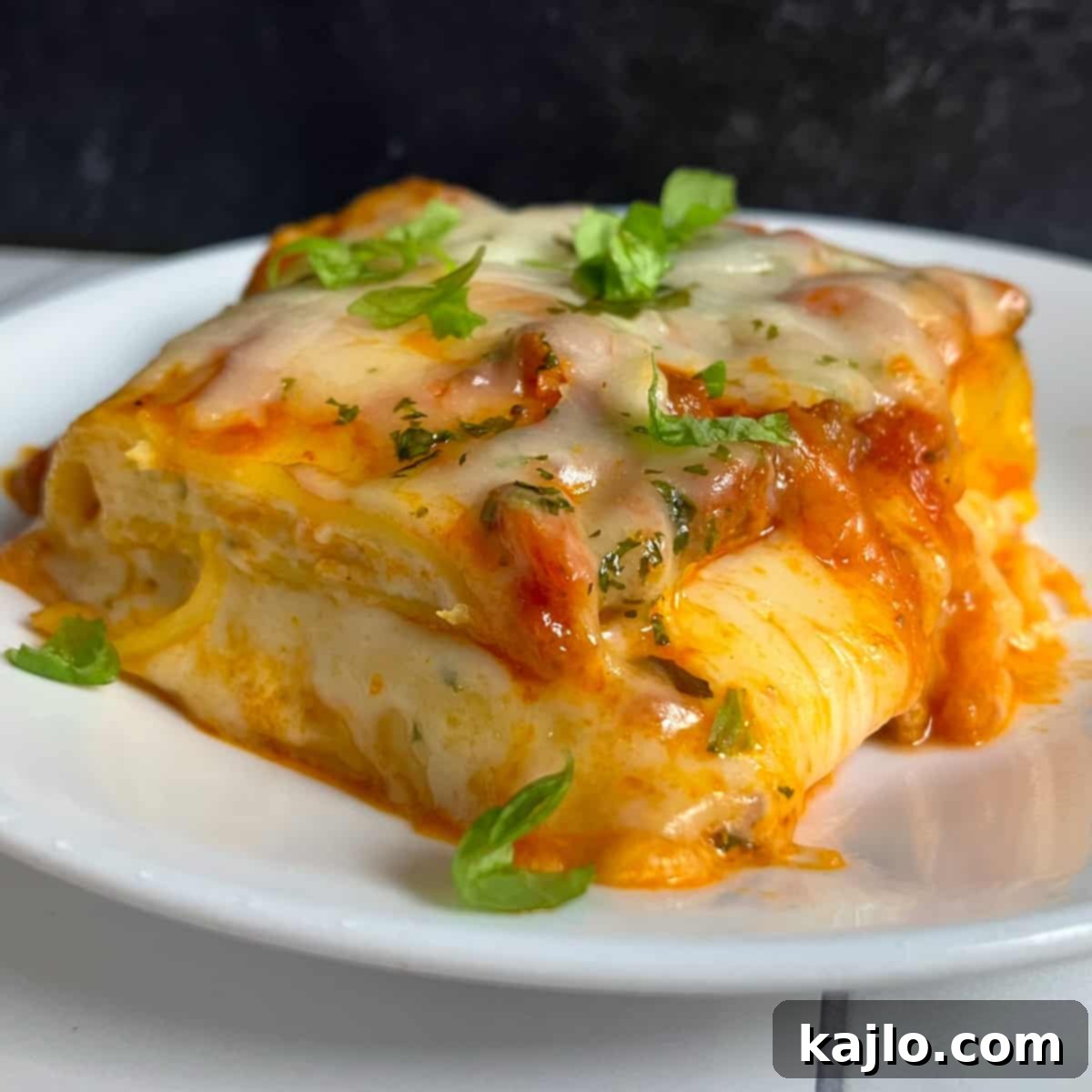Mastering Lasagna: Your Ultimate Guide to Baking Times and Temperatures
Lasagna, with its comforting layers of pasta, rich sauce, and melted cheese, is a beloved dish around the world. But achieving that perfect golden-brown top and bubbling, cooked-through center can sometimes feel like a culinary mystery. One of the most frequently asked questions revolves around the ideal baking time and temperature, especially: How long to cook lasagna at 350°F?
The standard baking time for lasagna in an oven preheated to 350°F (180°C) is typically between 65 to 75 minutes. This usually involves baking it covered with foil for the initial 50-55 minutes, then uncovering it for the final 15 minutes to allow the cheese to become beautifully golden and irresistibly melty. This comprehensive guide will delve into all the nuances of baking lasagna, offering expert tips for fresh and frozen versions, using no-boil noodles, handling raw meat, and adjusting for different oven temperatures to ensure your lasagna is always a culinary success.
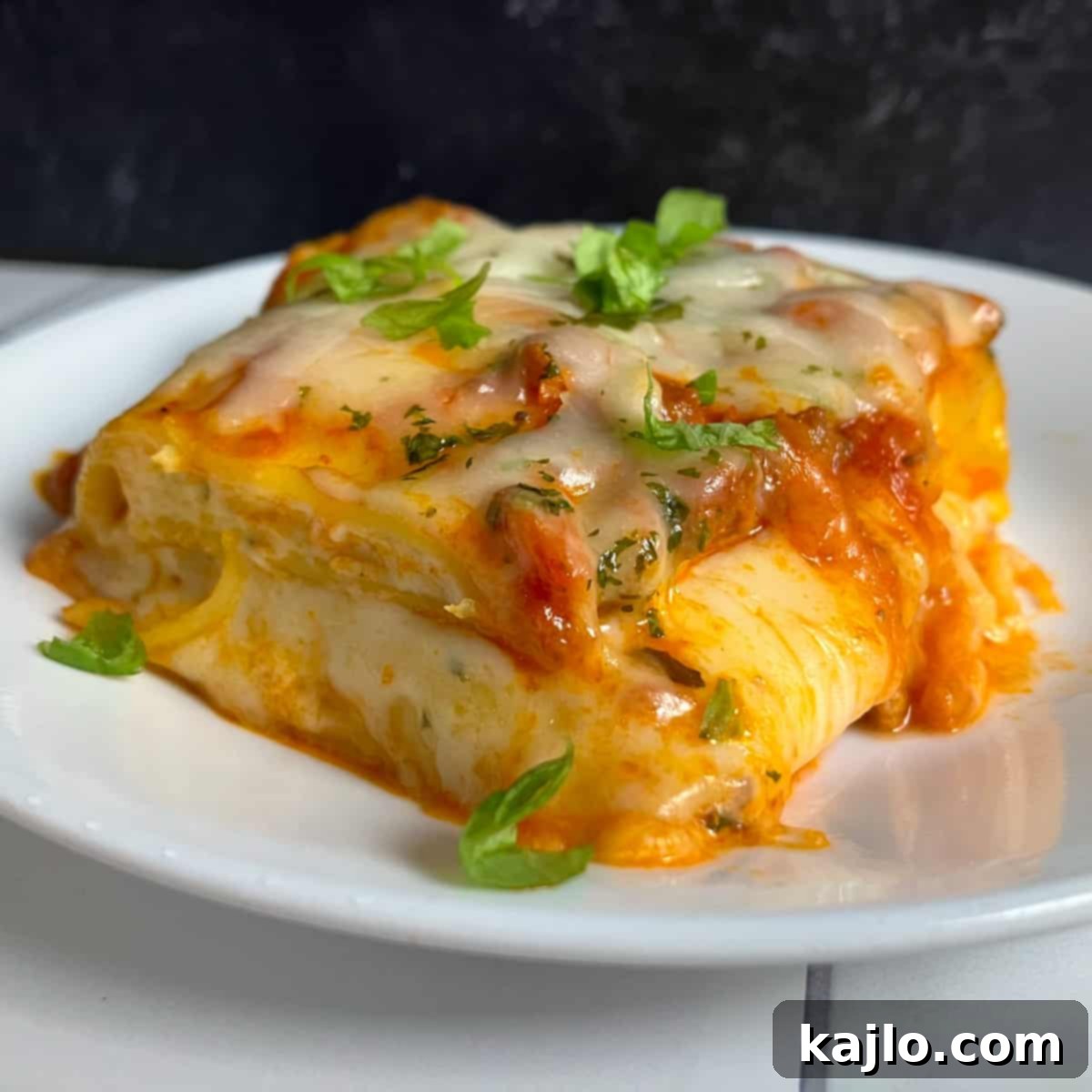
Factors Influencing Lasagna Baking Time
Understanding the variables that affect your lasagna cooking time is key to achieving consistent results. Several elements can significantly alter how long your lasagna needs to bake, impacting both texture and safety:
- The Size and Depth of the Lasagna: A very large or deep lasagna (e.g., a family-sized dish) will naturally require a longer baking period compared to a smaller, shallower individual portion. More mass means more time for heat to penetrate to the very center.
- Fresh vs. Frozen Lasagna: Freshly assembled lasagna cooks much faster than a frozen one, which needs extra time to thaw thoroughly and then cook all the way through. Adjustments are crucial here to avoid a cold center.
- Oven Temperature: As demonstrated in the table below, higher temperatures generally mean shorter baking times, while lower temperatures require longer periods. However, a moderate temperature often leads to more even and consistent cooking without scorching.
- Type of Noodles: Whether you’re using traditional noodles that need to be boiled al dente, or convenient no-boil noodles, affects baking. No-boil noodles often require ample moisture from the sauce to soften properly during baking.
- Cooked vs. Raw Meat: If your recipe incorporates raw meat directly into the layers, the overall baking time will increase significantly to ensure the meat reaches a safe internal temperature. Most recipes recommend pre-cooking and draining ground meat for the best texture and to prevent a greasy final dish.
- Baking Dish Material: Glass, ceramic, and metal pans conduct and retain heat differently. Glass and ceramic tend to hold heat longer and distribute it more evenly, potentially leading to slightly longer but more consistent baking compared to metal pans.
- Oven Calibration: Ovens can vary widely in accuracy. It’s always a good idea to use an external oven thermometer to verify that your oven is truly at the temperature it indicates, as this can greatly affect baking times.
For your convenience, here is a general table outlining lasagna baking times and temperatures. These guidelines are suitable for regular-sized lasagnas (typically in a 7×12 inch to 9×13 inch baking dish), whether you’re using a homemade recipe or a delicious pre-made option.
| Lasagna Oven Temp | Approximate Baking Time* |
|---|---|
| 325°F (163°C) | 75-90 minutes |
| 350°F (180°C) | 65-75 minutes |
| 375°F (190°C) | 60-70 minutes |
| 400°F (200°C) | 60-70 minutes |
| 425°F (218°C) | 40-50 minutes |
Whether you’re preparing a hearty ground beef lasagna, a vibrant vegetable lasagna, or your cherished family recipe, the core cooking principles remain consistent. Lasagna is essentially a casserole dish that requires reaching a minimum safe internal temperature before consumption, as recommended by food safety guidelines (USDA). The primary goal is to ensure all ingredients are thoroughly heated through, with the noodles tender and the cheese melted to perfection, offering both deliciousness and peace of mind.
⭐ How Long to Bake Lasagna at 350°F (180°C): A Detailed Guide
Baking lasagna at 350°F (180°C) is a popular and effective method that consistently yields excellent results. This moderate temperature allows for even cooking, ensuring all layers heat through without scorching the top. Here’s a detailed, step-by-step guide to achieving perfectly baked lasagna:
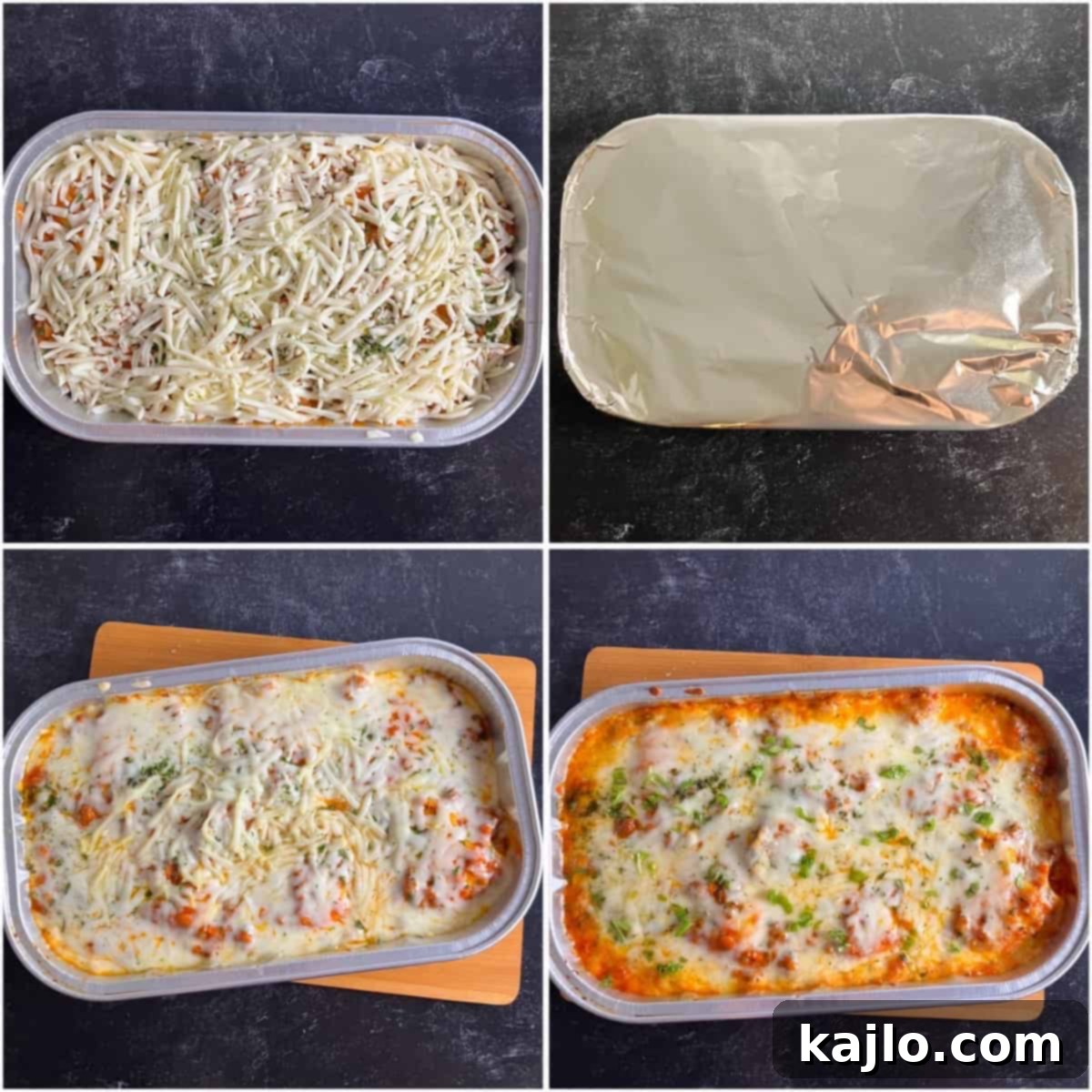
- Preheat Your Oven Accurately: Begin by preheating your oven to precisely 350°F (180°C). Using an oven thermometer can confirm your oven’s accuracy. A properly preheated oven ensures the lasagna starts cooking evenly from the moment it enters.
- Prepare the Foil Cover: Tear off a piece of heavy-duty aluminum foil large enough to cover your lasagna dish completely. Lightly spray one side of the foil with cooking oil (like olive oil or non-stick spray). This crucial step helps prevent the melty cheese from sticking to the foil during baking.
- Cover the Lasagna Securely: Carefully place the oiled foil over your lasagna dish, ensuring the oiled side faces down directly onto the cheese. Crimp the edges tightly around the pan to create a snug seal. This traps steam and moisture, essential for tender noodles and preventing the top from drying out or burning.
- Initial Bake (Covered): Position the lasagna on a rack in the middle-lower third of your oven (approximately one-third down from the top). Bake it covered for 50-55 minutes. This period allows the internal layers to heat up thoroughly and the noodles to soften perfectly.
- Uncover and Finish Baking: After the initial covered baking, carefully remove the foil. Be cautious of any hot steam that may escape. Return the lasagna to the oven and continue baking for an additional 15 minutes, or until the top layer of cheese is beautifully bubbly, golden-brown, and slightly crisp.
- Check for Doneness with a Thermometer: For ultimate food safety and reassurance, insert a food thermometer into the very center of the lasagna. The internal temperature should register a minimum of 165°F (74°C). If it hasn’t reached this temperature, return it to the oven for a few more minutes, checking periodically.
- Rest Before Serving: This is a critical, often overlooked step! Once removed from the oven, let the lasagna rest undisturbed for at least 10-15 minutes. Resting allows the layers to set, prevents the dish from becoming watery or messy when sliced, and ensures all the delicious flavors meld together beautifully for a cohesive, satisfying bite.
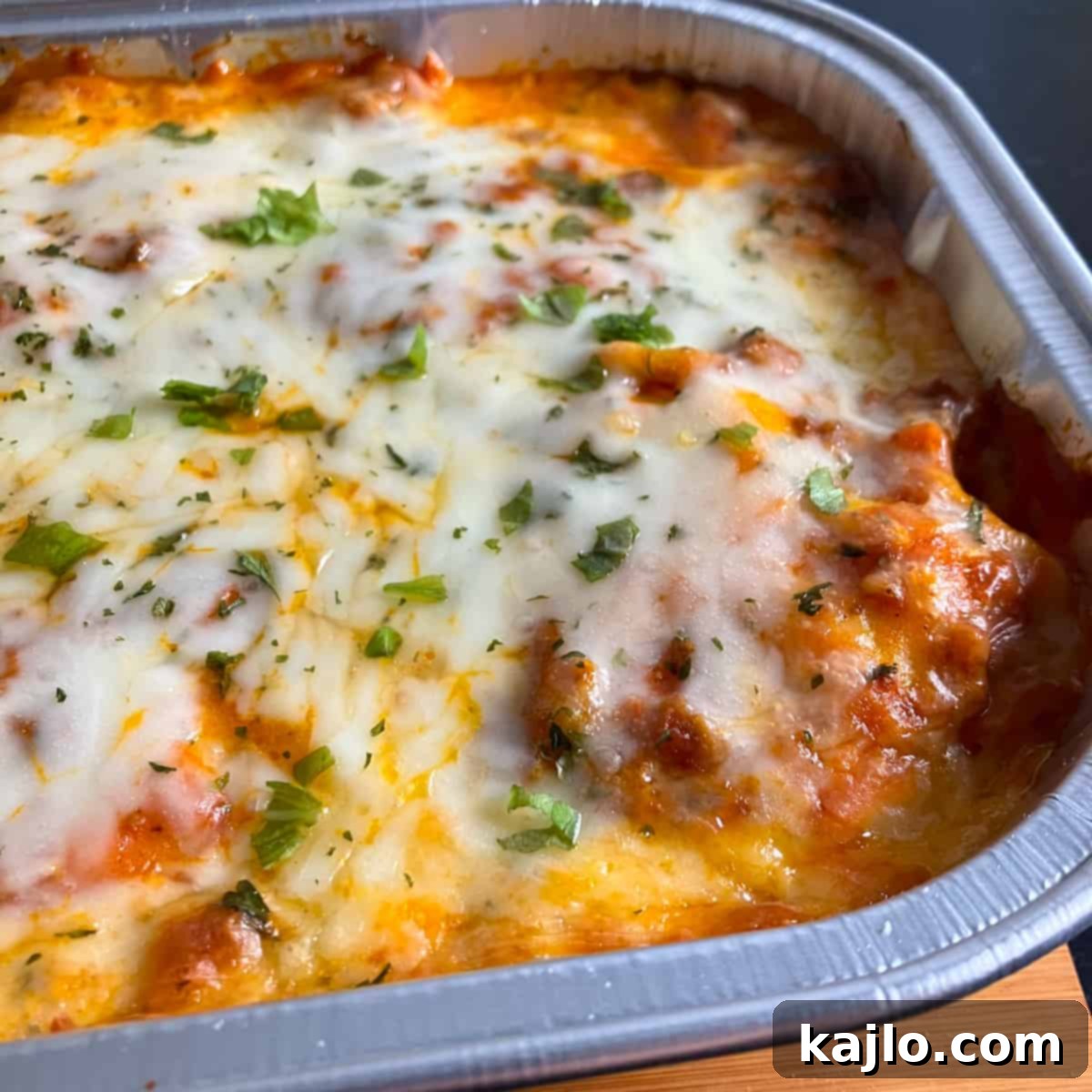
Baking Lasagna: The Importance of Covering and Uncovering
The decision to bake lasagna covered or uncovered plays a pivotal role in its final texture, moisture content, and appearance. Understanding this balance is key to a perfect dish:
- Cooking Lasagna Uncovered for the Entire Duration: This approach is generally not recommended. Baking lasagna completely uncovered can lead to the pasta drying out and becoming hard, particularly if you are using uncooked or no-boil noodles that rely on trapped steam to soften. Furthermore, the top layer of cheese is highly susceptible to burning or becoming overly crispy before the internal layers have had a chance to cook thoroughly, resulting in an unevenly baked dish.
- Cooking Lasagna Covered for the Entire Duration: While baking lasagna entirely covered ensures maximum moisture retention, which is excellent for tender noodles and preventing dryness, it comes with a cosmetic drawback. The cheese on top will not achieve that delightful golden-brown, bubbly, and slightly crispy crust that is characteristic of a well-baked lasagna. It will remain pale and merely melted. Therefore, a strategic combination of covered and uncovered baking is preferred to achieve both moist, tender layers and a perfectly gratified cheese topping.
How Long Do You Bake Lasagna Using Raw Meat?
While most lasagna recipes call for pre-cooked and thoroughly drained ground meat (like beef or Italian sausage), some traditional or rustic variations may incorporate raw meat directly into the layers. If you choose to use raw meat, your lasagna will require a significantly longer baking time to ensure the meat cooks completely and reaches a safe internal temperature. For instance, a recipe using raw meat and uncooked noodles might be baked at 350°F (180°C) for 90-100 minutes, with the first 60 minutes covered and the remaining 30-40 minutes uncovered.
Important Consideration: Using raw meat can also result in a greasier lasagna if the fat isn’t rendered and drained prior to assembly. For optimal flavor, texture, and reduced grease, pre-cooking and draining meat is generally the preferred method in modern lasagna preparation.
Baking Lasagna with No-Boil Noodles at 350°F
How long do I bake lasagna with uncooked noodles? No-boil noodles are a fantastic convenience that eliminates the need for a separate boiling step. When baking lasagna with no-boil noodles at 350°F (180°C), the total baking time typically falls between 65-75 minutes. The crucial aspect with these noodles is to keep the lasagna covered for the majority of this time (approximately 50-60 minutes), only uncovering it for the final 5-10 minutes to allow the cheese to brown. The trapped steam and moisture from the sauce are vital for softening these specific noodles.
A key tip for success with no-boil noodles is to ensure your recipe includes ample sauce. The liquid from your tomato, béchamel, or other sauces provides the necessary hydration for the noodles to absorb and cook to a perfect al dente texture. Do not skimp on the sauce when using no-boil pasta sheets.
Baking Multiple Lasagnas Simultaneously
If you’re preparing for a large gathering and need to bake two lasagnas at the same time, the general baking instructions typically still apply. This is true provided the pans fit comfortably on the same oven rack without crowding. Good air circulation around the pans is crucial for even heat distribution. If you must use two racks, consider rotating the pans halfway through baking to compensate for any oven hot spots.
However, if you’ve simply doubled a recipe into a much larger, deeper pan, or are baking very large commercial-sized lasagnas, the total baking time will likely be longer than for a standard single pan. Always rely on a food thermometer to check the internal temperature, especially when cooking larger or multiple dishes, as oven inconsistencies can affect cooking uniformity.
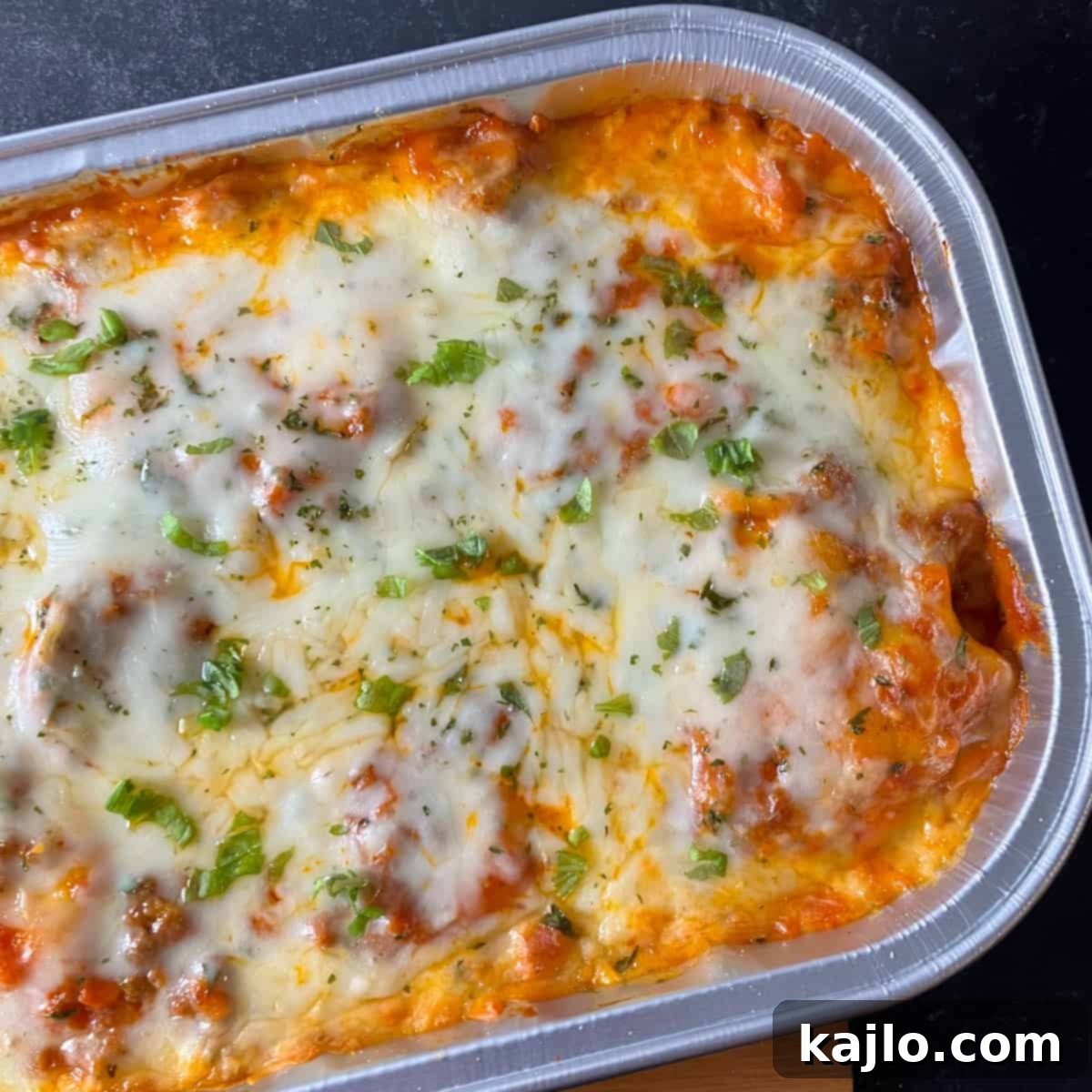
Enhancing the Taste of Your Lasagna
Beyond perfect baking, there are many simple yet effective ways to elevate your lasagna’s flavor profile and make it truly unforgettable. Consider incorporating some of these culinary enhancements:
- Savory Additions: A few extra tablespoons of finely crumbled bacon, diced pancetta, or deeply caramelized onions layered within the sauce can add incredible depth and umami.
- Diverse Cheese Blends: Don’t limit yourself to just mozzarella and Parmesan. Experiment with different cheese mixtures; a sprinkle of provolone, fontina, smoked gouda, or even a sharp aged cheddar can introduce new dimensions of flavor and texture.
- Fresh Herbs: Incorporating fresh basil leaves, chopped fresh parsley, oregano, or thyme layered throughout the lasagna or generously sprinkled on top after baking can brighten the flavors considerably and add a vibrant aromatic touch.
- Aromatic Boosters: Don’t shy away from adding an extra teaspoon or two of quality Italian seasoning, a pinch of red pepper flakes for a subtle kick, or freshly minced garlic cloves directly into your sauce or ricotta mixture for an intensified aroma and taste.
- Quality Ingredients: The foundation of a great lasagna starts with great ingredients. Using high-quality marinara sauce, fresh ricotta, and good-quality ground meat (if applicable) makes a noticeable difference in the final product.
Should You Bake Lasagna Covered or Uncovered?
The consensus among culinary experts and home cooks alike is to bake lasagna using a strategic combination of covered and uncovered baking. This dual approach leverages the best aspects of both methods. The general rule of thumb is to cook lasagna covered for the majority of the baking time, and then remove the foil near the end.
Covering the lasagna traps steam, ensuring that the noodles cook thoroughly and remain tender, preventing the dish from drying out. This also acts as a protective shield, preventing the top layer of cheese from burning prematurely before the rest of the lasagna is fully heated and cooked through. Uncovering the lasagna for the last 10-15 minutes is crucial. This final period allows the top layer of cheese to bubble vigorously, melt beautifully, and develop that appealing golden-brown, slightly crispy crust that makes homemade lasagna so irresistible. This ensures you get both moist, tender internal layers and a perfectly gratified, appetizing cheese topping.
Lasagna Baking Times at Other Temperatures
While 350°F (180°C) is a standard and reliable temperature for baking lasagna, you can certainly adjust your oven temperature based on your personal preference, time constraints, or to accommodate other dishes you might be baking simultaneously. Here’s a brief overview of how baking times change at different settings, always remembering the covered-then-uncovered principle:
🔥 How Long to Bake Lasagna at 375°F (190°C)
Baking lasagna at a slightly higher temperature of 375°F (190°C) typically shortens the total cooking time to 60-70 minutes. For optimal results, keep the lasagna covered with foil for the first 50-60 minutes, then remove the foil for the final 10-15 minutes to allow the cheese to brown beautifully. Always let the lasagna rest for a crucial 10-15 minutes after baking before slicing and serving. Remember to use a meat thermometer to confirm doneness and ensure food safety.
Do you bake lasagna at 350 or 375?
Both 350°F and 375°F are excellent and widely used temperatures for baking lasagna, and the choice often comes down to personal preference or the specific recipe you’re following. Baking at 375°F will generally shorten the total cooking time by approximately 5-15 minutes compared to 350°F. If you’re looking to shave a little time off your dinner prep, 375°F can be a good option. However, regardless of the temperature, it’s always wise to ensure your oven is well-calibrated to prevent uneven cooking or premature burning of the top layers.
🔥 How Long to Bake Lasagna at 400°F (200°C)
To bake lasagna at 400°F (200°C), plan for a total baking time of approximately 60-70 minutes. Maintain coverage with foil for the initial 50-60 minutes, then uncover for the last 5-10 minutes to achieve that desirable crispy, golden cheese topping. A resting period of 10-15 minutes post-baking is absolutely essential before cutting and serving. Always verify the internal temperature with a food thermometer to ensure thorough cooking.
🤔 How Long to Bake Lasagna at 325°F (163°C)
If you prefer a slower, more gentle bake that often results in very tender noodles and a deeply melded flavor, 325°F (163°C) is an excellent choice. At this lower temperature, lasagna will require a longer baking time, typically ranging from 75-90 minutes. Ensure it stays covered with foil for the first 55-70 minutes, then bake uncovered for the remaining 15-20 minutes. Don’t forget the vital 10-15 minute resting period. As with any recipe, always use a food thermometer to check for thorough cooking and safety.
⏲ How Long to Bake Lasagna at 425°F (218°C)
For a significantly quicker bake, 425°F (218°C) will reduce the total cooking time to 40-50 minutes. Bake the lasagna covered with foil for the first 35-40 minutes, then remove the foil for the final 5-10 minutes to achieve a golden, bubbly crust. A 10-15 minute rest is still crucial for the layers to set. Due to the higher temperature, it’s imperative to closely monitor the lasagna to prevent burning, and always use a food thermometer to ensure it reaches 165°F (74°C) internally.
🥶 How Long to Cook Frozen Lasagna at 350°F
Cooking frozen lasagna, whether store-bought or homemade, requires more time than baking a fresh one because it first needs to thaw and then cook through. The key is to allow for even heating without drying out the edges while the center remains frozen.
- Small, Single-Serve Frozen Lasagna (Air Fryer/Convection Oven): For smaller, individual portions, you can often cook a frozen lasagna in an air fryer oven preheated to 350°F (180°C) for approximately 45-60 minutes. Keep it covered with foil for most of the cooking duration, only uncovering for the last 3-5 minutes to brown the cheese. Be aware that air fryer cooking times can vary significantly between models, so check frequently with a food thermometer. This method is generally suitable for smaller lasagnas (e.g., 9.5 ounce/269g or similar single-serve options).
- Large Frozen Lasagna (Conventional Oven): For a standard-sized frozen lasagna (store-bought or a larger homemade batch), your conventional oven set to 350°F (180°C) is the ideal choice. Bake it for about 90 minutes. It’s critical to keep the lasagna covered with foil for the majority of this time, typically for the first 75-80 minutes, removing it only for the final 10-15 minutes to allow the cheese to melt and brown. As always, a food thermometer is your most reliable tool here to confirm the center reaches a safe 165°F (74°C).
When cooking frozen lasagna, patience is paramount. Avoid the temptation to crank up the heat too high, as this can easily lead to a burnt exterior while the interior remains cold or undercooked. A slower, more even heat is best for thorough thawing and cooking.
❓ How Do You Know When Lasagna Is Done?
The most reliable and safest way to determine if your lasagna is perfectly cooked and safe to eat is by checking its internal temperature. Insert a meat thermometer into the very center of the lasagna, ensuring the tip is not touching the bottom of the pan. The lasagna is done when the thermometer registers at least 165°F (74°C), which is the minimum safe internal temperature recommended by the USDA food safety guidelines for mixed dishes.
While visual cues such as bubbling edges, a golden-brown cheese topping, and tender noodles are good indicators, they aren’t foolproof for ensuring the entire dish, especially the dense center, has reached a safe and cooked-through temperature. A food thermometer provides scientific accuracy and peace of mind.
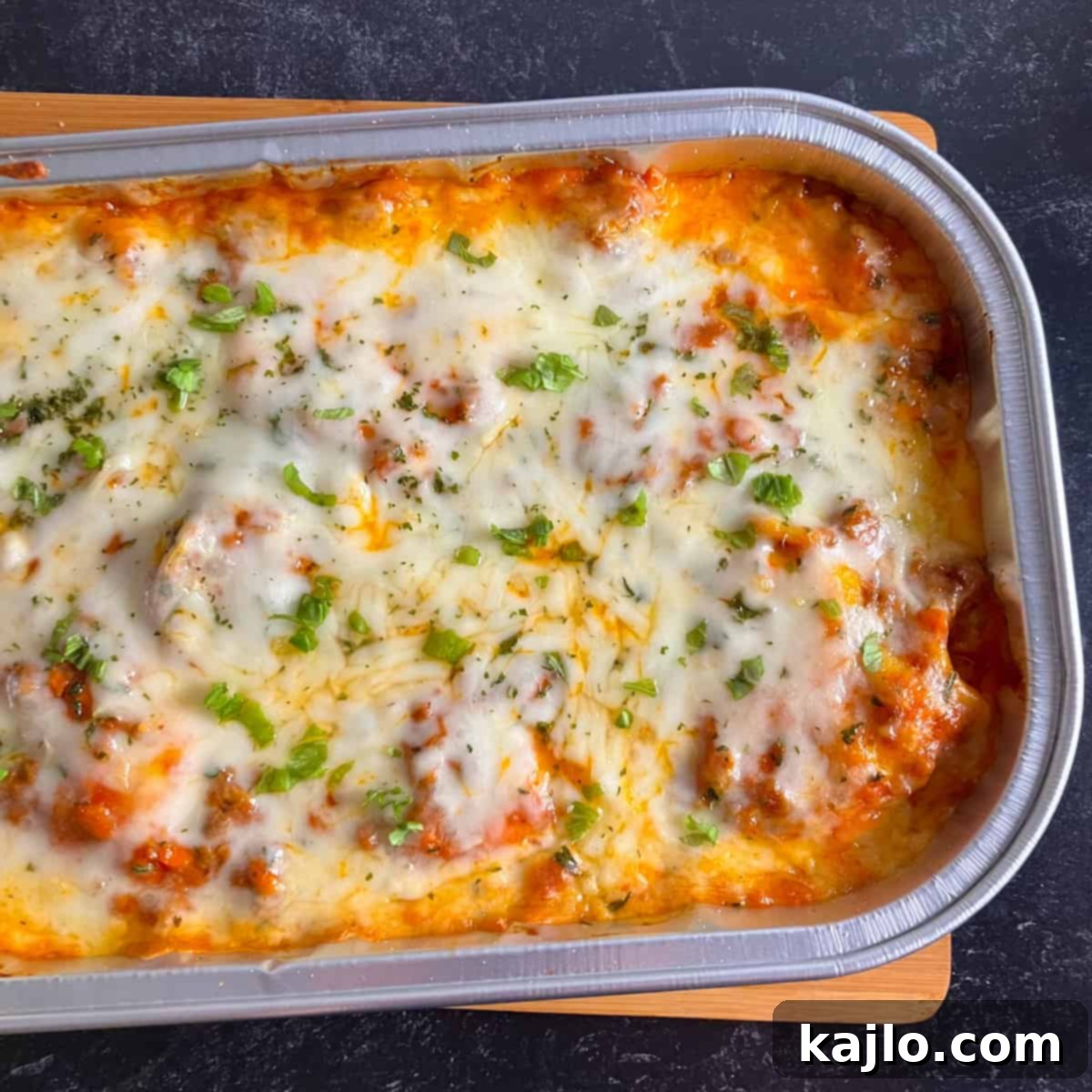
🌡️ Reheating and Storage Tips for Lasagna
How Do You Reheat Already Cooked Lasagna?
For reheating a single slice of fully cooked lasagna, the microwave is a quick option: heat for 3-5 minutes, or until piping hot throughout. For a larger portion or an entire tray of leftover lasagna, the oven is usually the best choice for even heating and maintaining texture. Preheat your oven to 375°F (190°C), cover the lasagna tightly with foil, and bake until it reaches an internal temperature of 165°F (74°C). This usually takes 20-30 minutes for a larger piece or 30-45 minutes for a full tray, depending on its size and how cold it is. Reheating all leftovers to 165°F (74°C) is crucial for ensuring food safety, as advised by the USDA.
How Long Can You Make Lasagna Ahead of Time?
Lasagna is an excellent dish for meal prepping, as it often tastes even better the next day! You can assemble it completely, cover it tightly with plastic wrap or foil, and store it in the refrigerator for up to 24 hours before baking. This allows flavors to meld beautifully. Keep in mind that a chilled lasagna will take a bit longer to bake than one assembled and immediately put into the oven, so adjust your baking time accordingly.
How Long Can Lasagna Sit Out Before Baking?
Like all perishable foods containing meat, dairy, and fresh vegetables, assembled lasagna should not be left at room temperature for more than 1-2 hours. This timeframe is critical for preventing the rapid growth of harmful bacteria. To maintain food safety and quality, if you’re not planning to bake your lasagna within that window, always store it promptly in the refrigerator until you’re ready to cook.
🥗 What to Serve with Lasagna
Lasagna is a hearty and satisfying main course, so pairing it with lighter side dishes can create a well-balanced and delicious meal. Here are some excellent accompaniments that complement its rich flavors:
- Crispy Air Fryer Meatballs (if serving a vegetarian lasagna)
- Fresh Vegan Spinach Salad or a simple green salad with a light vinaigrette to cut through the richness.
- Warm Garlic Bread or Garlic Knots for dipping in extra sauce.
- Air Fryer Spaghetti Squash as a lighter, vegetable-based alternative to pasta.
- Steamed or Air Fried Green Beans for a simple, healthy vegetable side.
- Homemade Italian Sausage (if you want to add an extra protein element to a cheese-only lasagna).
Frequently Asked Questions (FAQs) About Lasagna
How do you cook lasagna noodles before making lasagna?
Unless you are specifically using “no-boil” lasagna noodles, it’s generally best practice to pre-cook traditional lasagna noodles according to the package directions. This usually involves boiling them in a large pot of generously salted water for 8-10 minutes, or until they are al dente (firm to the bite). Overcooked noodles can become mushy, while undercooked ones may remain firm in the baked lasagna. After boiling, drain them well and you can lightly toss them with a little olive oil to prevent them from sticking together.
How many layers should lasagna have?
Most traditional and popular lasagnas typically feature 3 to 4 distinct layers of pasta, alternating with layers of sauce, cheese, and filling. This provides a good balance of ingredients, ensuring each bite offers a harmonious blend of flavors and textures, without making the dish excessively tall or difficult to manage in a standard lasagna pan. While two-layer lasagnas are certainly acceptable, they might appear thinner. Attempting to create more than 4-5 layers can result in a very deep lasagna, potentially increasing baking time and making it challenging to slice neatly.
Do you spray the bottom of a pan when making lasagna?
It’s generally not strictly necessary to spray the bottom of a lasagna pan if you ensure you start with a generous, even layer of sauce as the very first component. This foundational sauce layer usually provides enough moisture and lubrication to prevent the pasta from sticking to the bottom of the pan during baking. However, using a light coat of cooking spray or a thin layer of olive oil doesn’t hurt and can provide extra assurance, especially if you’ve experienced sticking issues in the past or are using a pan known for food adhesion.
Which layer goes down first in lasagna?
The very first layer in any lasagna should always be a thin, even layer of sauce (whether it’s marinara, meat sauce, Alfredo, or another type of sauce). This foundational layer serves multiple crucial purposes: it prevents the initial layer of pasta from sticking to the bottom of the pan, helps to hydrate and begin softening the first layer of noodles, and establishes a flavorful base for the entire dish to build upon.
Should the top layer of lasagna be noodles or sauce?
The top layer of lasagna is traditionally a generous spread of cheese, commonly a blend of shredded mozzarella and grated Parmesan cheese, with a layer of tomato or meat sauce directly beneath it. Underneath the sauce comes the final layer of pasta, followed by the main filling (such as ricotta cheese mixture, vegetables, or meat). This sequence ensures the cheese gets beautifully golden and bubbly when uncovered during the final baking stage, creating an appealing and delicious crust.
Why does my lasagna get watery?
Watery lasagna is a common issue that can usually be attributed to a couple of factors. The most frequent cause is not allowing the lasagna to rest adequately after baking. Resting for 10-15 minutes allows the hot liquids to be reabsorbed and the layers to set and firm up, resulting in a cohesive, sliceable lasagna. Another significant reason could be using ingredients with too much inherent moisture, such as excessively wet ricotta cheese (ensure it’s well-drained) or a very thin, watery sauce. If your sauce seems too thin, you can try simmering it longer to reduce it or stirring in a tablespoon or two of tomato paste to naturally thicken it.
How Long Should Lasagna Sit Before Being Cut?
As repeatedly emphasized, allowing lasagna to rest after it comes out of the oven is crucial for optimal results. A general rule of thumb is to let it sit undisturbed for 10-15 minutes before attempting to cut into it. This resting period allows the hot cheese and sauce to settle and solidify slightly, making for much cleaner, more presentable slices that hold their shape beautifully on the plate.
Lasagna Nutrition Facts
Lasagna’s nutritional content can vary widely depending on the specific ingredients used (e.g., type of meat, amount of cheese, inclusion of vegetables) and the portion size. The following information provides an estimate for one standard 3-inch by 3-inch (7.6×7.6 cm) square of beef lasagna. Please note this is an average, and your homemade or store-bought lasagna may differ based on recipe variations.
- Calories: 320 kcal
- Total Fat: 15g
- Saturated Fat: 7g
- Cholesterol: 50mg
- Total Carbohydrate: 25g
- Fiber: 2.5g
- Total Sugars: 4g
- Added Sugars: 0g
- Protein: 21g
- Vitamin A: 7.3% DV
- Vitamin C: 13.7% DV
- Iron: 12.9% DV
- Calcium: 30.5% DV
It’s important to remember that traditional lasagna, made with wheat-based pasta and dairy, is generally not considered low-carb, keto-friendly, or gluten-free. However, many alternative recipes exist that use substitutions to cater to these dietary needs.
Nutrition Information Disclaimer
All recipes and nutrition information presented on this website are for general informational purposes only and may not be suitable for all individuals. It is always recommended to consult with a registered dietitian or your physician to determine the best dietary pattern for your specific medical needs and personal preferences.
The nutrition information provided is an estimate and should be used as a courtesy. Actual values may vary significantly based on the specific brands, ingredients, and preparation methods you use. Please be aware that calorie information on food labels can sometimes be inaccurate, so focus more on balanced eating rather than rigidly adhering to numerical values.
“To taste” refers to adjusting ingredients according to your personal preference, but always ensure food safety rules are followed. Never consume undercooked food.
Featured Lasagna Recipe: How to Bake Lasagna at 350°F
Here’s a simplified recipe demonstrating how to bake a classic lasagna at 350°F (180°C), focusing on the key steps for perfect results every time. This recipe assumes you are using pre-cooked or no-boil noodles and pre-cooked meat if applicable.
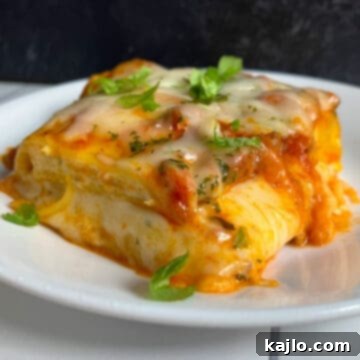
Classic Lasagna Bake (at 350°F)
A simple guide to baking delicious, perfectly cooked lasagna with optimal timing and a golden-brown cheese topping.
Yields: 8 servings
Cook Time: 1 hour 5 minutes
Total Time: 1 hour 5 minutes (plus resting time)
Ingredients
- 1 assembled lasagna (standard 7×12 inch to 9×13 inch or 17.8×30.5 cm to 22.9×33 cm baking dish)
- Cooking oil spray (e.g., olive oil or vegetable oil spray)
- Aluminum foil
- (Optional) Meat thermometer for accurate temperature checks
Instructions
- Preheat your oven to 350°F (180°C).
- Tear off a piece of aluminum foil large enough to cover your lasagna dish completely. Lightly spray one side of the foil with cooking oil.
- Carefully cover the lasagna with the foil, ensuring the oiled side faces down directly onto the cheese layer. Crimp the edges tightly around the pan to seal.
- Place the covered lasagna on an oven rack positioned about one-third down from the top. Bake for 50-55 minutes.
- After the initial covered baking, carefully remove the foil (watch for steam). Return the lasagna to the oven and continue baking for another 15 minutes, or until the cheese is bubbly, golden-brown, and slightly crisp.
- For food safety, insert a food thermometer into the center of the lasagna. It should read at least 165°F (74°C). If it hasn’t reached this temperature, return it to the oven for a few more minutes, checking periodically.
- Once cooked, remove the lasagna from the oven and allow it to rest for a crucial 15 minutes before cutting and serving. This resting period helps the layers set, making for cleaner and more presentable slices.
- Special Tip for Frozen Lasagna: If cooking a frozen lasagna (standard size) at 350°F (180°C), bake it for approximately 90 minutes. Keep it covered with foil for the first 75-80 minutes, then uncover for the last 10-15 minutes to brown the cheese. Always use a meat thermometer to ensure the internal temperature reaches 165°F (74°C).
Equipment
- Aluminum Foil
- Kitchen Thermometer (Instant-read recommended)
- Baking Dish (7×12 to 9×13 inches)
Notes from the Dietitian
This recipe provides a foundation for delicious lasagna, suitable for general weight maintenance and active lifestyles. The nutritional profile of lasagna can vary significantly based on the specific ingredients chosen. For example, a lasagna packed with fatty meats and cheeses will have a different nutrient density than one that emphasizes vegetables and leaner protein sources.
Traditional lasagna recipes typically cover your grain, dairy, and protein groups. To create a more balanced and nutrient-dense meal, consider incorporating low-calorie, high-volume vegetables. According to MyPlate guidelines, fruits and vegetables should constitute half of your plate. Therefore, pairing your lasagna with a large, fresh side salad or steamed green vegetables like broccoli or asparagus is an excellent choice to balance the carbohydrate and calorie density of the dish.
The nutrition information provided (320 kcal per 3×3 inch slice) is an estimate and will depend entirely on your specific ingredients, brands, and precise portion sizes. Always prioritize a balanced approach to eating.
Join our community! Subscribe for all of the latest and greatest recipes, and follow me on Facebook, Pinterest, Instagram, and YouTube!
